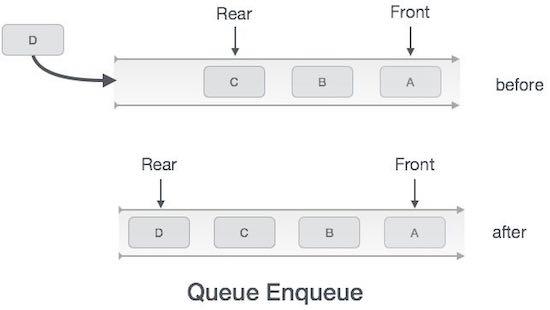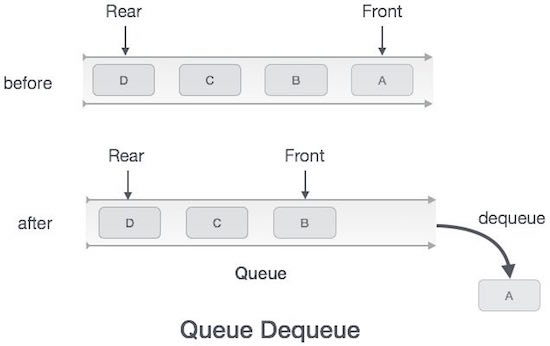Queue data structure (Queue)
What is the queue data structure (Queue)?
Queue (Queue) is an abstract data structure, is something similar to queues in everyday life (queuing).

Other than the stack, the queue is open at both ends. One end is always used to insert input (also known as incoming rows) and the other end is used to delete data (leaving the row). The queue data structure follows the First-In-First-Out method, ie the first entered data will be accessed first.
In real life, we have many examples of queues, such as cars on one-way roads (especially when traffic is blocked), in which the first car will exit first. Some other examples are queuing up students, queuing up for tickets, .
Demonstration of queue data structure (Queue)
Now you probably imagine what a queue is. We can access both ends of the queue. Below is a queue representation in the form of data structures:

Similar to the stack data structure, the queue data structure can also be deployed using Arrays (Array), Link list (Linked List), Pointer (Pointer) and Structure (Struct ). For simplicity, the next section will learn more about queues deployed using one-dimensional arrays.
Basic operations on queue data structure
Activities on the queue data structure may involve queuing initialization, using data on the queue and then deleting data from memory. The list below is some basic operations that can be performed on queue data structures:
Enqueue () : add (or store) an element into the queue.
Operation dequeue () : delete an element from the queue.
In order to use queues effectively, we also need to check the status of the queue. For this purpose, here are some other support features of the queue:
The peek () method : takes the element at the top of the queue, without deleting this element.
IsFull () method : check if the queue is full.
IsEmpty () : check if the queue is empty or not.
In the queue data structure, we always: (1) dequeue (delete) the data pointed by the front pointer and (2) enqueue (enter) the data into the queue by the help of the rear pointer .
In the next section we will learn about the support features of the queue data structure:
The peek () method of the queue data structure
As in the stack data structure, this function helps us look at the data at the top of the queue. The algorithm of the peek () function is:
b ắ t đầ u h à m peek return queue [ front ] k ế t th ú c h à m
Deployment of the peek () function in C language:
int peek () { return queue [ front ]; } The isFull () method in the queue data structure
If when we are using a one-way array to deploy the queue, we only need to check if the rear pointer has reached MAXSIZE to determine if the queue is full. In the case of queue deployment by using Round Linked List, the algorithm for isFull () function will be different.
The following is the algorithm of isFull () function:
b ắ t đầ u h à m isfull if rear equals to MAXSIZE return true else return false endif k ế t th ú c h à m
Algorithm deployment of isFull () function in C language:
bool isfull () { if ( rear == MAXSIZE - 1 ) return true ; else return false ; } IsEmpty () method in the queue data structure
The algorithm of isEmpty () function:
b ắ t đầ u h à m isempty if front l à nh ỏ h ơ n MIN OR front l à l ớ n h ơ n rear return true else return false k ế t th ú c if k ế t th ú c h à m
If the value of the front is less than MIN or 0, then the queue has not been initialized yet, so the queue is empty.
Here is the code deployment in C language:
bool isempty () { if ( front < 0 || front > rear ) return true ; else return false ; } Operate enqueue in queue data structure
Because the queue data structure maintains two data pointers: front and rear, so the operation of this type of data structure is quite complicated when compared to the stack data structure.
Here are the steps to enqueue (insert) data into the queue:
Step 1 : check if the queue is full.
Step 2 : If the queue is full, the process fails and is exited.
Step 3 : If the queue is not full, increase the rear pointer to point to the next available memory location.
Step 4 : Add the data element to the position where the rear cursor is pointing to the queue.
Step 5 : return success.

Sometimes we also need to check if the queue has been initialized to handle unexpected situations.
Algorithm for enqueue operation in queue data structure
b ắ t đầ u enqueue ( data ) if queue l à đầ y return overflow endif rear ← rear + 1 queue [ rear ] ← data return true k ế t th ú c h à m
The algorithm deployment of enqueue () operation in C language:
int enqueue ( int data ) if ( isfull ()) return 0 ; rear = rear + 1 ; queue [ rear ] = data ; return 1 ; k ế t th ú c h à m
To monitor the full code deployment of the above activities in C language, please click on chapter: Queue in C.
Operation dequeue in queue data structure
Accessing data from the queue is a two-step process: access the data where the front cursor is pointing and delete the data after accessing it. Here are the steps to perform dequeue :
Step 1: check if the queue is empty.
Step 2 : If the queue is empty, the process fails and is exited.
Step 3 : If the queue is not empty, access the data where the front cursor is pointing.
Step 4 : Increase the front pointer to point to the location containing the next element.
Step 5 : return success.

Algorithms for dequeue operation
b ắ t đầ u h à m dequeue if queue l à tr ố ng return underflow end if data = queue [ front ] front ← front + 1 return true k ế t th ú c h à m
Dequeue () operation deployment in C language:
int dequeue () { if ( isempty ()) return 0 ; int data = queue [ front ]; front = front + 1 ; return data ; } To monitor the full code deployment of the above activities in C language, please click on chapter: Queue in C.
Store queues
According to Tutorialspoint
Previous article: Stack data structure (Stack)
Next article: Linear search algorithm (Linear Search)
You should read it
May be interested
- How to delete playlists on Spotify
 spotify supports an extremely useful feature that allows you to create playlists (queues). you can optionally add any songs you want to this list and they will be played in order.
spotify supports an extremely useful feature that allows you to create playlists (queues). you can optionally add any songs you want to this list and they will be played in order. - Structure (Struct) in C programming
 arrays in c allow you to define several types of variables that can hold the values of several components of the same type. but the structure is another type of data in the c programming language, which allows you to combine other types of data.
arrays in c allow you to define several types of variables that can hold the values of several components of the same type. but the structure is another type of data in the c programming language, which allows you to combine other types of data. - Graph data structure (Graph)
 a graph (graph) is a form of visual representation of a set of objects in which pairs of objects are connected by links. interconnected objects are represented by points called vertices, and links that connect vertices are called edges.
a graph (graph) is a form of visual representation of a set of objects in which pairs of objects are connected by links. interconnected objects are represented by points called vertices, and links that connect vertices are called edges. - What is the best URL structure for SEO?
 many visitors will reach your website by clicking on a link, so you might be wondering if what's in the url of a particular page is really important.
many visitors will reach your website by clicking on a link, so you might be wondering if what's in the url of a particular page is really important. - Is the data structure and algorithm necessary for a Web Developer?
 is the data structure and algorithm necessary for a web developer? let's tipsmake.com find out in the article below!
is the data structure and algorithm necessary for a web developer? let's tipsmake.com find out in the article below! - How to implement a graph data structure in Golang
 charts are one of the essential data structures that you must know as a programmer. let's learn how to create graph/graph data structures in golang !
charts are one of the essential data structures that you must know as a programmer. let's learn how to create graph/graph data structures in golang ! - How to Implement a Stack Data Structure in C++
 a stack is a basic data structure that is commonly used throughout computer science. for example, a stack is utilized by your web browser to remember the last few pages you were on. developers and programmers should be very familiar with...
a stack is a basic data structure that is commonly used throughout computer science. for example, a stack is utilized by your web browser to remember the last few pages you were on. developers and programmers should be very familiar with... - What is Silo Structure? Advantages and disadvantages of silos and effective alternatives
 everyone knows that a properly structured website is good for both users and seo. silo structure is one of many ways that seo experts recommend people to apply for their website.
everyone knows that a properly structured website is good for both users and seo. silo structure is one of many ways that seo experts recommend people to apply for their website. - Deep search algorithm
 deep search algorithms (depth first search - dfs for short), also called depth-first search algorithms, are algorithms that browse or search on a tree or graph and use the stack ( stack) to remember adjacent vertices to start the search when the adjacent vertex is not encountered in any loop.
deep search algorithms (depth first search - dfs for short), also called depth-first search algorithms, are algorithms that browse or search on a tree or graph and use the stack ( stack) to remember adjacent vertices to start the search when the adjacent vertex is not encountered in any loop. - Environment settings in Data structures
 because c and c ++ languages are the languages that almost every university uses to teach, in this chapter i will guide you to install c and c ++ to run the examples in the configuration series. structure and algorithm.
because c and c ++ languages are the languages that almost every university uses to teach, in this chapter i will guide you to install c and c ++ to run the examples in the configuration series. structure and algorithm.










 Linear search algorithm (Linear Search)
Linear search algorithm (Linear Search) Binary Search algorithm (Binary Search)
Binary Search algorithm (Binary Search) Interpolation Search algorithm (Interpolation Search)
Interpolation Search algorithm (Interpolation Search)